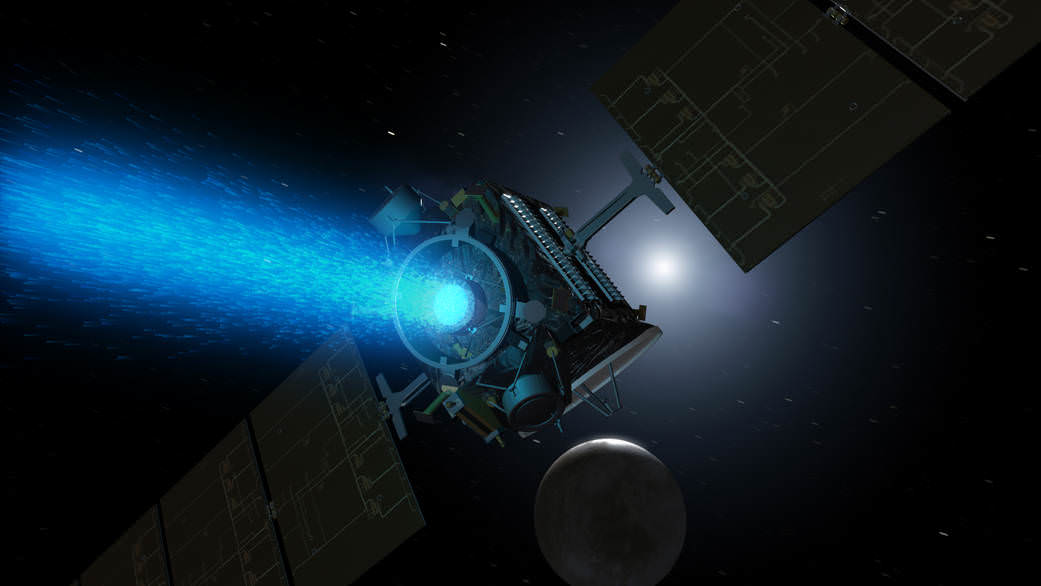The Dawn spacecraft, NASA’s asteroid hopping probe, may not be going gently into that good night as planned. Dawn has visited Vesta and Ceres, and for now remains in orbit around Ceres. The Dawn mission was supposed to end after its rendezvous with Ceres, but now, reports say that the Dawn team has asked NASA to extend the mission to visit a third asteroid.
Dawn was launched in 2007, and in 2011 and 2012 spent 14 months at Vesta. After Vesta, it reached Ceres in March 2015, and is still in orbit there. The mission was supposed to end, but according to a report at New Scientist, the team would like to extend that mission.
Dawn is still is fully operational, and still has some xenon propellant remaining for its ion drive, so why not see what else can be achieved? There’s only a small amount of propellant left, so there’s only a limited selection of possible destinations for Dawn at this point. A journey to a far-flung destination is out of the question.
Chris Russell, of the University of California, Los Angeles, is the principal investigator for the Dawn mission. He told New Scientist, “As long as the mission extension has not been approved by NASA, I’m not going to tell you which asteroid we plan to visit,” he says. “I hope a decision won’t take months.”
If the Dawn mission is not extended, then its end won’t be very fitting for a mission that has accomplished so much. It will share the fate of some other spacecraft at the end of their lives; forever parked in a harmless orbit in an out of the way place, forgotten and left to its fate. The only other option is to crash it into a planet or other body to destroy it, like the Messenger spacecraft was crashed into Mercury at the end of its mission.
The crash and burn option isn’t available to Dawn though. The spacecraft hasn’t been sterilized. If it hasn’t been sterilized of all possible Earthly microbial life, then it is strictly forbidden to crash it into Ceres, or another body like it. Planetary protection rules are in place to avoid the possible contamination of other worlds with Earthly microbial life. It’s not likely that any microbes that may have hitched a ride aboard Dawn would have survived Dawn’s journey so far, nor is it likely that they would survive on the surface of Ceres, but rules are rules.
The secret of Dawn’s long-life and success is not only due to the excellent work by the teams responsible for the mission, it’s also due to Dawn’s ion-drive propulsion system. Ion drives, long dreamed of in science and science fiction, are making longer voyages into deep space possible.
Ion drives start very slow, but gain speed incrementally, continuing to generate thrust over long distances and long periods of time. They do all this with minimal propellant, and are ideal for long space voyages like Dawn’s.
The success of the Dawn mission is key to NASA’s plans for further deep space exploration. NASA continues to work on improving ion drives, and their latest project is the Advanced Electric Propulsion System (AEPS.) This project is meant to further develop the Hall Thruster, a type of ion-drive that NASA hopes will extend spacecraft mission capabilities, allow longer and deeper space exploration, and benefit commercial space activities as well.
The AEPS has the potential to double the thrust of current ion-drives like the one on Dawn. It’s a key component of NASA’s Journey to Mars. NASA also has plans for a robotic asteroid capture mission called Asteroid Redirect Mission, which will use the AEPS. That mission will visit an asteroid, retrieve a boulder- sized asteroid from the surface, and place it in orbit around the Moon. Eventually, astronauts will visit it and return samples to Earth for study. Very ambitious.
As far as the Dawn mission goes, it’s unclear what its next destination might be. Vesta and Ceres were chosen because they are thought be surviving protoplanets, formed at the same time as the other planets. But they stopped growing, and they remain largely undisturbed, so in that sense they are kind of locked in time, and are intriguing objects of study. There are other objects in the vicinity, but it would be pure guesswork to name any.
We are prone to looking at the past nostalgically, and thinking of prior decades as the golden age of space exploration. But as Dawn, and dozens of other current missions and scientific endeavours in space show us, we may well be in a golden age right now.


This is very surprising. The critical fuel at this point isn’t the xenon propellant for the ion engines, but the hydrazine used by attitude control thrusters (necessary since 2 out of 4 reaction wheels failed). The mission is/was supposed to end with that (very low) supply in a few months. I have no idea how it could outlive any decision delay, plus the time to climb out of Ceres orbit, plus the time to cruise to another target, and still be able to maneuver once there.
Also the main purpose of the present lowest orbit (LAMO) is to operate the GRAND instrument (gamma ray and neutron spectrometer) for as long as possible, so that the incremental data quality is as high as possible. Are they really willing to sacrifice this? Sounds weird within the limited available info.
Perhaps they’re planning some kind of flyby that will require just two reaction wheels.
Maybe it could rendezvous with Deep Space 1? :-^)
I think staying at Ceres and continuing observations is the best possible stratedgy. IF Occator crater’s (Geyser’s?) bright spots grew further, say at perihelion.. that would speak volumes.